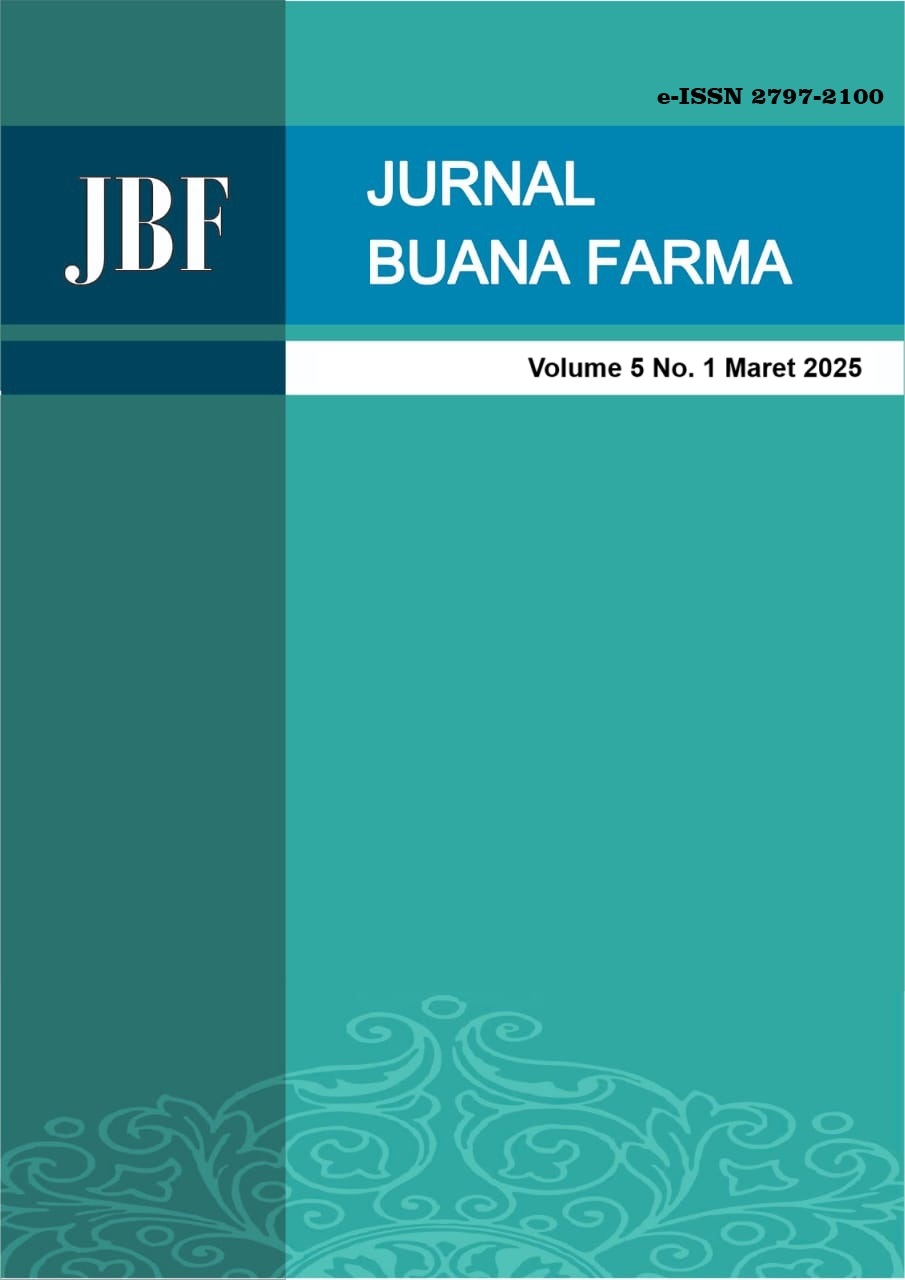POTENSI AKTIVITAS ANTIINFLAMASI DAN ANTIKANKER DARI EKSTRAK DAN FRAKSI DAUN ALPUKAT DAN DAUN PEPAYA: NARRATIVE REVIEW
Abstrak
Daun alpukat dan daun pepaya secara empiris telah banyak digunakan masyarakat Indonesia sebagai obat tradisional dengan berbagai macam khasiat. Penemuan dan pengembangan obat baru yang mengarah pada pemanfaatan tanaman obat berkhasiat memicu dibutuhkannya informasi yang akurat dan terpercaya khususnya terkait daun alpukat dan daun pepaya dalam pengobatan penyakit kanker dan inflamasi. Penulisan artikel ini bertujuan untuk mengetahui potensi dari daun alpukat dan daun pepaya baik dalam bentuk ekstrak maupun fraksi terhadap aktivitas antiinflamasi dan antikanker yang dihimpun dalam artikel narrative review. Pencarian artikel sebagai bahan referensi penulisan dilakukan dengan menggabungkan kata kunci dan boolean operator (AND, OR) yang diketikkan pada situs database artikel seperti Google Scholar, PubMed, dan Researchgate. Terdapat kriteria inklusi dalam pencarian artikel yaitu artikel yang relevan pada jurnal yang telah terpublikasi pada tahun 2015 hingga 2024, artikel tersedia dalam full-text berbahasa Indonesia atau Inggris, serta diperoleh dari desain penelitian experimental study. Berdasarkan hasil seleksi artikel jurnal, diperoleh sebanyak 23 artikel jurnal yang telah memenuhi kriteria inklusi untuk dilakukan proses review. Hasil pengkajian 23 artikel menunjukkan bahwa daun alpukat dan daun pepaya telah terbukti secara ilmiah memiliki aktivitas farmakologi sebagai antiinflamasi dan antikanker baik dalam bentuk ekstrak maupun fraksi. Adapun kandungan senyawa metabolit sekunder yang diduga bertanggung jawab terhadap dihasilkannya aktivitas antiinflamasi dan antikanker pada tanaman daun alpukat dan daun pepaya adalah senyawa golongan flavonoid.
Referensi
Aisyah, A. N., Nur, S., Lukitaningsih, E., Rumiyati, R., Burhan, A., Adjara, S. M., & Rahim, K. (2020). Efek Sitotoksik Ekstrak dan Fraksi Umbi Paku Atai Merah (Angiopteris ferox Copel) Terhadap Sel Kanker Payudara T47D. Jurnal Farmasi Galenika (Galenika Journal of Pharmacy) (e-Journal), 6(2). https://doi.org/10.22487/j24428744.2020.v6.i2.15255
Alhassan, H. M., Galadima, S. A., Isiyaku, A., Aliyu, U. M., Bunza, Z. M., Abdullahi, H., & Bello, M. (2024). Immunomodulatory activity of methanolic extract of Carica papaya leaf on biochemical markers and serum level of IL-1β in breast cancer-induced Wistar Rats. Sokoto Journal of Medical Laboratory Science, 9(2), 228–238. https://doi.org/10.4314/sokjmls.v9i2.27
Al-Khayri, J. M., Sahana, G. R., Nagella, P., Joseph, B. V., Alessa, F. M., & Al-Mssallem, M. Q. (2022). Flavonoids as Potential Anti-Inflammatory Molecules: A Review. In Molecules (Vol. 27, Issue 9). MDPI. https://doi.org/10.3390/molecules27092901
Altun, İ., & Sonkaya, A. (2018). The Most Common Side Effects Experienced by Patients Were Receiving First Cycle of Chemotherapy. Iranian Journal of Public Health, 47(8), 1218–1219.
Aulianshah, V., Thaharah, Y. R., Zakiah, N., & Handayani, R. (n.d.). Anti-Inflammatory Effect Of Carica Papaya Leaves Extract In Male Wistar Rats Based On Variation Of Concentration. In International Journal of Health and Pharmaceutical. https://ijhp.net
Auriel, E., Regev, K., & Korczyn, A. D. (2014). Nonsteroidal anti-inflammatory drugs exposure and the central nervous system (pp. 577–584). https://doi.org/10.1016/B978-0-7020-4086-3.00038-2
Averus Kautsar-detikHealth. (2024). Kepala BPOM Ungkap Obat Kanker di RI Masih Mahal dan Terbatas, Ini Penyebabnya. Https://Health.Detik.Com/Berita-Detikhealth/d-7679747/Kepala-Bpom-Ungkap-Obat-Kanker-Di-Ri-Masih-Mahal-Dan-Terbatas-Ini-Penyebabnya.
Bakhtra, D. D. A., Fajrina, A., & Ameliona, P. (2024). Uji Aktivitas Sitotoksik Ekstrak n-Heksan Daun Alpukat (Persea americana Mill) Terhadap Sel Kanker Kulit B16F0 Dengan Metode Microculture Tetrazolium Test. Jurnal Farmasi Higea, 16(1), 6–10. www.jurnalfarmasihigea.org
Balai Besar POM di Semarang. (2023). Manakah Yang Aman - Obat Atau Obat Tradisonal? Https://Semarang.Pom.Go.Id/Berita/Manakah-Yang-Aman-Obat-Atau-Obat-Tradisonal.
Basim, S., & Kasim, A. (2023). Cytotoxic Activity of the Ethyl Acetate Extract of Iraqi Carica papaya Leaves in Breast and Lung Cancer Cell Lines. Asian Pacific Journal of Cancer Prevention, 24(2), 581–586. https://doi.org/10.31557/APJCP.2023.24.2.581
Brai, B. I. C., Falode, J. A., Adisa, R. A., & Odetola, A. A. (2020). Effects of aqueous leaf extract of avocado (Persea americana) on total cholesterol, triacylglycerols, protein and haematological parameters in CCl4-intoxicated rats. Clinical Phytoscience, 6(1), 14. https://doi.org/10.1186/s40816-020-00159-y
Cao, Y., Lai, K. M., Fu, K. C., Kuo, C. L., Tan, Y. J., Yu, L., & Huang, D. (2024). Dual Functionality of Papaya Leaf Extracts: Anti-Coronavirus Activity and Anti-Inflammation Mechanism. Foods, 13(20). https://doi.org/10.3390/foods13203274
Femilian, A., Agustina, D., & Subagyo, G. (2019). The effect of papaya leaf extract (Carica papaya L) on healing process of buccal traumatic ulcer in wistar rats. Majalah Kedokteran Gigi Indonesia, 1(1), 15. https://doi.org/10.22146/majkedgiind.37026
García-Gurrola, A., Martínez, A. L., Wall-Medrano, A., Olivas-Aguirre, F. J., Ochoa-Ruiz, E., & Escobar-Puentes, A. A. (2024). Phytochemistry, Anti-cancer, and Anti-diabetic Properties of Plant-Based Foods from Mexican Agrobiodiversity: A Review. Foods, 13(24), 4176. https://doi.org/10.3390/foods13244176
Gutierrez Jr, P. M. (2023). Anti-cancer activity of Carica papaya leaf ethanolic extract and fractions against selected human cancer cell lines. International Journal of Biosciences (IJB), 23(1), 1–8. https://doi.org/10.12692/ijb/23.1.1-8
Hasanah, F., & Hidayah, N. (2019). Test Of Anti-Inflamation Activities of Pepaya Leaf (Carica papaya L.) Extract on Male Wistar Rats Induced By Caragenan 1%. Jurnal Natural, 19(3), 54–57. https://doi.org/10.24815/jn.v19i3.12498
Hidayah, H., Widyaningsih, A., Pangestu, A. D., & Dewi, S. R. (2023). Literatur Riview: Flavonoid Activity As an Anti-Cancer Compound. MAHESA : Malahayati Health Student Journal, 3(5), 1255–1263. https://doi.org/10.33024/mahesa.v3i5.10296
Kamilla, L., Tumpuk, S., & Salim, M. (2021). Anti-Inflammatory of Papaya Leaf Extract (Carica Papaya L) Towards Membrane Stabilization of Red Blood Cells. Jurnal Kesehatan Prima, 15(1), 1–7. https://doi.org/10.32.248/jkp.v15i1.399
Kumar, A., Kumarchandra, R., Rai, R., & Sanjeev, G. (2017). Anticlastogenic, radiation antagonistic, and anti-inflammatory activities of Persea americana in albino Wistar rat model. In Research in Pharmaceutical Sciences (Vol. 12, Issue 6). http://journals.lww.com/rips
Lutfiah, I. W., Lestari, T., & Laili Dwi, N. (2023). Uji Aktivitas Anti-Inflamasi Ekstrak Etanol Daun Alpukat (Persea americana Mill) Terhadap Tikus Putih Jantan Galur Wistar. In Prosiding Seminar Nasional Diseminasi Penelitian (Vol. 3).
M. Ibrahim, N., & J. Kadhim, E. (2017). Phytochemical Investigation and Antioxidant Activity of Iraqi Tribulus terrestris. Iraqi Journal of Pharmaceutical Sciences ( P-ISSN 1683 - 3597 E-ISSN 2521 - 3512), 24(1), 68–73. https://doi.org/10.31351/vol24iss1pp68-73
Mahmoud, A. H., Samy, M. N., Wanas, A. S., & Kamel, M. S. (2021). Gas chromatography-mass spectrometry profiling and analgesic, anti-inflammatory, antipyretic, and antihyperglycemic potentials of Persea americana. Iranian Journal of Basic Medical Sciences, 24(5), 641–649. https://doi.org/10.22038/ijbms.2021.53390.12016
Mahmoud, A. H., Samy, M. N., Wanas, A. S., & Kamel, M. S. (2021). Gas chromatography-mass spectrometry profiling and analgesic, anti-inflammatory, antipyretic, and antihyperglycemic potentials of Persea americana. Iranian Journal of Basic Medical Sciences, 24(5), 641–649. https://doi.org/10.22038/IJBMS.2021.53390.12016
Marcum, Z. A., & Hanlon, J. T. (2010). Recognizing the Risks of Chronic Nonsteroidal Anti-Inflammatory Drug Use in Older Adults. The Annals of Long-Term Care : The Official Journal of the American Medical Directors Association, 18(9), 24–27.
Mardiyaningsih, A., & Ismiyati, N. (2014). Cytotoxic Activity of Ethanolic Extract of Persea Americana Mill. Leaves on Hela Cervical Cancer Cell. Traditional Medicine Journal, 19(1), 24–28.
Marin, A. O., Parra-Ruiz, C., Rivas, F., Orellana, J. F., Garcia-Diaz, D. F., & Jimenez, P. (2020). Characterization of persea Americana mill. Peels and leaves extracts and analysis of its potential in vitro anti-inflammatory properties. Boletin Latinoamericano y Del Caribe de Plantas Medicinales y Aromaticas, 19(4), 395–407. https://doi.org/10.37360/BLACPMA.20.19.4.27
Masri, M., & Azalia, D. (2024). Cytotoxicity Test of Ethyl Acetate Fraction and Ethanol Fraction of Papaya Leaf Extract (Carica Papaya. L) Against Hep-2 Laryngeal Cancer Cells Uji Sitotoksisitas Fraksi Etil Asetat dan Fraksi Etanol Ekstrak Daun Pepaya (Carica Papaya. L) terhadap Sel Kanker Laring Hep-2. Radinka Journal of Health Science, 1(1). https://www.rjupublisher.com/ojs/index.php/RJHS
Miskin, N. R., Katagi, M. S., Bolakatti, G., & kamala Sunita, V. (2020). In-Vitro Cytotoxic Activity of Persea Americana Miller Leaves Extracts. International Journal of Medicine and Pharmaceutical Research In-Vitro Cytotoxic Activity of Persea Americana Miller Leaves Extracts. International Journal of Medicine and Pharmaceutical Research, 8(2), 58–62. https://www.researchgate.net/publication/353347240
Morsy, N. (2014). Phytochemical analysis of biologically active constituents of medicinal plants. Main Group Chemistry, 13(1), 7–21. https://doi.org/10.3233/MGC-130117
Nigam, M., Mishra, A. P., Deb, V. K., Dimri, D. B., Tiwari, V., Bungau, S. G., Bungau, A. F., & Radu, A.-F. (2023). Evaluation of the association of chronic inflammation and cancer: Insights and implications. Biomedicine & Pharmacotherapy, 164, 115015. https://doi.org/10.1016/j.biopha.2023.115015
Nisa, F. Z., Astuti, M., Murdiati, A., & Haryana, S. M. (2017). Anti-proliferation and apoptosis induction of aqueous leaf extract of Carica papaya L. On human breast cancer cells MCF-7. Pakistan Journal of Biological Sciences, 20(1), 36–41. https://doi.org/10.3923/pjbs.2017.36.41
Nur, S., Aisyah, A. N., Lukitaningsih, E., Rumiyati, Juhardi, R. I., Andirah, R., & Hajar, A. S. (2021). Evaluation of antioxidant and cytotoxic effect against cancer cells line of Angiopteris ferox Copel tuber and its compounds by LC-MS analysis. Journal of Applied Pharmaceutical Science, 11(8), 54–61. https://doi.org/10.7324/JAPS.2021.110808
Nwosu, N. (2024). Cancer: A Disease of Modern Times? Cureus. https://doi.org/10.7759/cureus.74666
Pandey, S., Walpole, C., Shaw, P. N., Cabot, P. J., Hewavitharana, A. K., & Batra, J. (2018). Bio-guided fractionation of papaya leaf juice for delineating the components responsible for the selective anti-proliferative effects on prostate cancer cells. Frontiers in Pharmacology, 9(NOV). https://doi.org/10.3389/fphar.2018.01319
Renggana, H., Asman Sadino, Risa Susanti, Rahmi, & Sujana, D. (2022). Sitotoksisitas Ekstrak Etanol Dan Fraksi-Fraksi Daun Pepaya (Carica papaya L.) Terhadap Sel Kanker Prostat DU 145 Dengan Metode MTT Assay. Medical Sains : Jurnal Ilmiah Kefarmasian, 7(2), 119–128. https://doi.org/10.37874/ms.v7i2.346
Sari, N. P. R., Bodhi, W., & Lebang, J. S. (2021). Uji Efek Antiinflamasi Ekstrak Etanol Daun Pepaya (Carica papaya L.) Pada Tikus Putih Jantan (Rattus norvegicus). Pharmacon, 10(3), 985–993.
Sentat, T., & Permatasari, R. (2015). Uji Aktivitas Ekstrak Etanol Daun Alpukat (Persea americana Mill.) Terhadap Penyembuhan Luka Bakar Pada Punggung Mencit Putih Jantan (Mus musculus). Jurnal Ilmiah Manuntung, 1(2), 100–106.
Shaikh, T. I., Afroz, S., Mujtaba, T., Tabassum, H., Hasan, A., Naz, A., Sodhar, U., Jawaid, W., Anjum, W., & Ara, A. (2024). The Anti-Inflammatory Potential of Carica Papaya Linn. Leaves: An In Vivo Study. Journal of Population Therapeutics & Clinical Pharmacology, 31(7), 425–434. https://doi.org/10.53555/jptcp.v31i7.6990
Sharma, A., Sharma, R., Sharma, M., Kumar, M., Barbhai, M. D., Lorenzo, J. M., Sharma, S., Samota, M. K., Atanassova, M., Caruso, G., Naushad, M., Radha, Chandran, D., Prakash, P., Hasan, M., Rais, N., Dey, A., Mahato, D. K., Dhumal, S., … Mekhemar, M. (2022a). Carica papaya L. Leaves: Deciphering Its Antioxidant Bioactives, Biological Activities, Innovative Products, and Safety Aspects. In Oxidative Medicine and Cellular Longevity (Vol. 2022). Hindawi Limited. https://doi.org/10.1155/2022/2451733
Sharma, A., Sharma, R., Sharma, M., Kumar, M., Barbhai, M. D., Lorenzo, J. M., Sharma, S., Samota, M. K., Atanassova, M., Caruso, G., Naushad, Mo., Radha, Chandran, D., Prakash, P., Hasan, M., Rais, N., Dey, A., Mahato, D. K., Dhumal, S., … Mekhemar, M. (2022b). Carica papaya L. Leaves: Deciphering Its Antioxidant Bioactives, Biological Activities, Innovative Products, and Safety Aspects. Oxidative Medicine and Cellular Longevity, 2022, 1–20. https://doi.org/10.1155/2022/2451733
Singh, N., Baby, D., Rajguru, J., Patil, P., Thakkannavar, S., & Pujari, V. (2019). Inflammation and cancer. Annals of African Medicine, 18(3), 121. https://doi.org/10.4103/aam.aam_56_18
Singh, S. P., Kumar, S., Mathan, S. V, Singh Tomar, M., Rishi, &, Singh, K., Kumar Verma, P., Kumar, A., Kumar, S., Singh, R. P., & Acharya, A. (2020). Therapeutic application of Carica papaya leaf extract in the management of human diseases. Journal of Pharmaceutical Science, 28, 735–744. https://doi.org/10.1007/s40199-020-00348-7/Published
Singh, S. P., Kumar, S., Mathan, S. V., Tomar, M. S., Singh, R. K., Verma, P. K., Kumar, A., Kumar, S., Singh, R. P., & Acharya, A. (2020). Therapeutic application of Carica papaya leaf extract in the management of human diseases. DARU Journal of Pharmaceutical Sciences, 28(2), 735–744. https://doi.org/10.1007/s40199-020-00348-7
Tulunay, M., Aypak, C., Yikilkan, H., & Gorpelioglu, S. (2015). Herbal medicine use among Turkish patients with chronic diseases. Journal of Intercultural Ethnopharmacology, 4(3), 217. https://doi.org/10.5455/jice.20150623090040
WHO. (2023). Catalysing ancient wisdom and modern science for the health of people and the planet. https://www.who.int/initiatives/who-global-centre-for-traditional-medicine
WHO. (2025). Cancer. Https://Www.Who.Int/News-Room/Fact-Sheets/Detail/Cancer.
Widiyastuti, Y., Pratiwi, R., Riyanto, S., & Wahyuono, S. (2018). Cytotoxic activity and apoptosis induction of avocado Persea americana Mill. seed extract on MCF-7 cancer cell line. Indonesian Journal of Biotechnology, 23(2), 61. https://doi.org/10.22146/ijbiotech.32141
Yuliani, R., & Syahdeni, F. (2020). Ethanolic Extract of Papaya Leaves (Carica papaya) and its Fractions have no Potential Cytotoxicity on T47D Cells. In Jurnal Farmasi Indonesia (Vol. 17, Issue 1). http://journals.ums.ac.id/index.php/pharmacon
Yusuf, F., Widya Rochmatil Ulla, U., Simbolon, M., Studi Diploma Tiga Farmasi, P., & Tinggi Ilmu Kesehatan Arjuna Laguboti, S. (2023). Antibacterial Test Of Avocado Leaf Ethanol Extract (Persea americana Mill) ON Staphylococcus Aureus Bacteria. In International Journal Of Health, Engineering And Technology (IJHET) (Vol. 2, Issue 4). https://afdifaljournal.com/journal/index.php/ijhet
Zhang, J., Onakpoya, I. J., Posadzki, P., & Eddouks, M. (2015). The Safety of Herbal Medicine : From Prejudice to Evidence. 2015.













